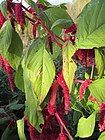Note: This is a project under development. The articles on this wiki are just being initiated and broadly incomplete. You can Help creating new pages.
Amaranthus caudatus - Pendant amaranth
Amaranthus caudatus is a fast-growing vigorous annual plant with an erect stem that is usually moderately branched. It grows upto 50 - 150cm tall. The plant has a long history of cultivation for its edible leaves and seeds in the Andes.
Contents
[hide]- 1 Uses
- 2 Parts Used
- 3 Chemical Composition
- 4 Common names
- 5 Properties
- 6 Habit
- 7 Identification
- 8 List of Ayurvedic medicine in which the herb is used
- 9 Where to get the saplings
- 10 Mode of Propagation
- 11 How to plant/cultivate
- 12 Commonly seen growing in areas
- 13 Photo Gallery
- 14 References
- 15 External Links
Uses
Parts Used
Chemical Composition
The isolation of seven triterpenoid saponins (1-7) is reported, among them three new natural products (1-3), together with three new ionol-derived glycosides (8-10) from the MeOH extract of the leaves of Amaranthus caudatus (Amaranthaceae).[1]
Common names
| Language | Common name |
|---|---|
| Kannada | |
| Hindi | |
| Malayalam | |
| Tamil | |
| Telugu | |
| Marathi | |
| Gujarathi | |
| Punjabi | |
| Kashmiri | |
| Sanskrit | |
| English | Pendant amaranth |
Properties
Reference: Dravya - Substance, Rasa - Taste, Guna - Qualities, Veerya - Potency, Vipaka - Post-digesion effect, Karma - Pharmacological activity, Prabhava - Therepeutics.
Dravya
Rasa
Guna
Veerya
Vipaka
Karma
Prabhava
Habit
Identification
Leaf
| Kind | Shape | Feature |
|---|---|---|
Flower
| Type | Size | Color and composition | Stamen | More information |
|---|---|---|---|---|
| {{{5}}} |
Fruit
| Type | Size | Mass | Appearance | Seeds | More information |
|---|---|---|---|---|---|
Other features
List of Ayurvedic medicine in which the herb is used
Where to get the saplings
Mode of Propagation
How to plant/cultivate
Amaranthus caudatus is a plant of the tropics, though it can be cultivated from the tropics to the temperate zones. It grows best in areas where annual daytime temperatures are within the range 21 - 28°c, but can tolerate 7 - 40°c.[3]
Commonly seen growing in areas
Cultivated ground, Andean mountains at elevations.
Photo Gallery
References
- Jump up ↑ Chemistry
- Jump up ↑ [Morphology]
- Jump up ↑ Cultivation
External Links
- Ayurvedic Herbs known to be helpful to treat Strangury
- Ayurvedic Herbs known to be helpful to treat Scrofulous sores
- Herbs with Leaves used in medicine
- Herbs with Seeds used in medicine
- Herbs with common name in English
- Habit - Annual
- Index of Plants which can be propagated by Seeds
- Herbs that are commonly seen in the region of Cultivated ground
- Herbs that are commonly seen in the region of Andean mountains at elevations
- Herbs
- Pages without herbs images





